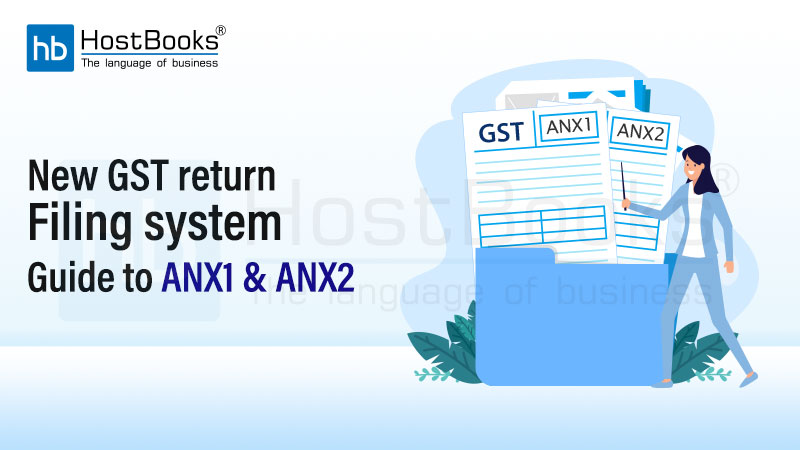New GST return filing system – Guide to ANX-1 & ANX-2

In its 31st meeting held on December 22nd, 2018, GST Council introduced a lot of changes to the existing GST return filing process. A new return filing system was introduced under GST, containing simplified return forms, to ease the compliance burden of taxpayers. Under this new return system, there will be one main return GST RET-1, which will be filed on a monthly or quarterly basis, and two main annexures: GST ANX-1 and GST ANX-2.
The new GST return will have to be filed on a monthly basis, except for small taxpayers having turnover of up to ₹5 Crore in the preceding financial year who can opt for quarterly filing of returns. Contrary to the 16/17(if annual return filed) returns filed by all taxpayers previously, under the new return system, taxpayers will have to file just 4 returns annually. Under the process termed Continuous Upload, taxpayers will have the ability to upload transactions at any time of the month.
What is the new GST return filing system?
Under the new return system, decided to be implemented from 1st April 2020, the proposed main return called FORM GST RET-1 will contain details of all outward supplies, availed input tax credit, and payment of taxes, along with interest and late fees, if any. This return form will have two annexures, namely, FORM GST ANX-1 (Annexure of Outward Supplies) and FORM GST ANX-2 (Annexure of Inward Supplies).
FORM GST ANX-1 will contain the details of all outward supplies, inward supplies that are liable to reverse charge, and import of goods and services, that needs to be reported invoice-wise (except for B2C supplies) in real-time. On the other hand, FORM GST ANX-2 will contain the details of all inward supplies and will allow the recipient of supplies to take action on the auto-drafted documents uploaded by the supplier, available on a real-time basis.
What is FORM GST ANX-1?
Form GST ANX-1 is an annexure filed along with GST RET-1/2/3 under the new GST return system. This annexure will contain details pertaining to all outward supplies, inward supplies attracting reverse charge, and import of goods or services. The taxpayers can report invoice-wise details in this annexure upon the availability of continuous invoice uploading facility on the GST portal.
Furthermore, the invoices in GST ANX-1 can be uploaded by the supplier on a real-time basis and can be viewed simultaneously by the recipient of supplies in their FORM GST ANX-2 to take the desired action.
What is FORM GST ANX-2?
Form GST ANX-2 is an annexure to the GST RET-1/2/3. It is an auto-drafted return form containing the details of inward supplies, available for the recipient of supplies to take necessary action, i.e. accept, reject or mark the documents as pending. If the recipient accepts these documents, it would mean that the supplies reported in Form GST ANX-1 are correct.
The recipient can take three actions in GST ANX-2: accept, reject, or mark as pending. If no action is taken for any particular transaction, it will be considered Accepted by default.
General FAQs on New GST Return
To help you easily understand the new GST return filing system, here are the answers to all the frequently asked questions about the terms and concepts related to New GST returns –RET-1, ANX-1, ANX-2, RET-2 (Sahaj), and RET-3 (Sugam).
Q.1 Can the taxpayer change the return filing period from quarterly to monthly or vice versa?
Q.2 What are the types of regular returns available for a taxpayer who chooses to file his returns quarterly?
Q.3 What actions can be taken by the recipient with regards to the auto-populated documents uploaded by the supplier?
Q.4 When will the supplier be intimated that the recipient has rejected the document uploaded by him?
Q.5 I have uploaded all the document details correctly but have entered them in the wrong table in form ANX-1. Is there any quick solution available?
Q.6 Can the supplier make an amendment in documents that are left pending by the recipient?
Q.7 Who can file a NIL return?
- No document has been uploaded in Form GST ANX-1
- No inward supplies (purchases) have been auto-populated in Form GST ANX-2
- No other information needs to be reported in the main return i.e. GST RET-1/2/3.
Q.8 Under what circumstances can Form RET-1 be filed through SMS?
Q.9 Certain details have been auto-populated into my Form RET-1. What is the source of these details?
Q.10 What is the purpose of Form ANX-1A?
Q.11 What is the due date for filing the new GST return?
Q.12 What is the due date for the payment of taxes?

